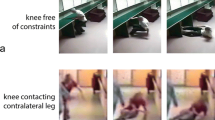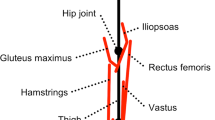Abstract
Summary
The magnitude of hip impact force during a fall on the ground (i.e., concrete surface) from standing height was determined. We found that this force decreases up to 59%, depending on how they land on the ground.
Introduction
We determined the magnitude of hip impact force that humans may experience in the event of a fall from standing height on the ground, in order to examine how the hip impact force was affected by characteristics of a fall.
Methods
Twenty subjects mimicked a typical older adults’ falls on a mat. Trials were acquired with three initial fall directions: forward, sideways, and backward. Trials were also acquired with three knee positions at the time of hip impact: knee together, knee on the mat, and free knee. During falls, attenuated vertical hip impact forces and corresponding depression of the mat were measured via a force plate placed under the mat and motion capture system, respectively. Using a mass-spring model, actual hip impact force and body stiffness during a fall on the ground were estimated.
Results
Hip impact force averaged 4.0 kN (SD = 1.7). The hip impact force was associated with knee condition (F = 25.6, p < 0.005), but not with fall direction (F = 0.4, p = 0.599). Compared with “knee on the mat,” hip impact force averaged 59% and 45% greater in “free knee” and “knee together,” respectively (4.6 versus 2.9 kN, p < 0.005; 4.3 versus 2.9 kN, p < 0.005). However, the hip impact force did not differ between “free knee” and “knee together (4.6 versus 4.3 kN, p = 0.554).
Conclusion
Our results suggest that hip fracture risk during a fall decreases substantially, depending on how they land on the ground, informing the development of safe landing strategies to prevent fall-related hip fractures in older adults.




Similar content being viewed by others
References
Empana JP, Dargent-Molina P, Breart G (2004) Effect of hip fracture on mortality in elderly women: the EPIDOS prospective study. J Am Geriatr Soc 52(5):685–690. https://doi.org/10.1111/j.1532-5415.2004.52203.x
Wolinsky FD, Fitzgerald JF, Stump TE (1997) The effect of hip fracture on mortality, hospitalization, and functional status: a prospective study. Am J Public Health 87(3):398–403
Florence CS, Bergen G, Atherly A, Burns E, Stevens J, Drake C (2018) Medical costs of fatal and nonfatal falls in older adults. J Am Geriatr Soc 66(4):693–698. https://doi.org/10.1111/jgs.15304
CDC (2015) 2004–2013, United States unintentional fall death rates per 100,000 all races, both sexes, ages over 65. Center for Disease Control and Prevention
Robinovitch SN, Evans SL, Minns J, Laing AC, Kannus P, Cripton PA, Derler S, Birge SJ, Plant D, Cameron ID, Kiel DP, Howland J, Khan K, Lauritzen JB (2009) Hip protectors: recommendations for biomechanical testing--an international consensus statement (part I). Osteoporos Int 20(12):1977–1988. https://doi.org/10.1007/s00198-009-1045-4
Lotz JC, Hayes WC (1990) The use of quantitative computed tomography to estimate risk of fracture of the hip from falls. J Bone Joint Surg Am 72(5):689–700
Courtney AC, Wachtel EF, Myers ER, Hayes WC (1994) Effects of loading rate on strength of the proximal femur. Calcif Tissue Int 55(1):53–58
Bouxsein ML, Courtney AC, Hayes WC (1995) Ultrasound and densitometry of the calcaneus correlate with the failure loads of cadaveric femurs. Calcif Tissue Int 56(2):99–103
Pinilla TP, Boardman KC, Bouxsein ML, Myers ER, Hayes WC (1996) Impact direction from a fall influences the failure load of the proximal femur as much as age-related bone loss. Calcif Tissue Int 58(4):231–235
Cheng XG, Lowet G, Boonen S, Nicholson PH, Brys P, Nijs J, Dequeker J (1997) Assessment of the strength of proximal femur in vitro: relationship to femoral bone mineral density and femoral geometry. Bone 20(3):213–218
Cheng XG, Lowet G, Boonen S, Nicholson PH, Van der Perre G, Dequeker J (1998) Prediction of vertebral and femoral strength in vitro by bone mineral density measured at different skeletal sites. J Bone Miner Res 13(9):1439–1443. https://doi.org/10.1359/jbmr.1998.13.9.1439
Bouxsein ML, Coan BS, Lee SC (1999) Prediction of the strength of the elderly proximal femur by bone mineral density and quantitative ultrasound measurements of the heel and tibia. Bone 25(1):49–54
Keyak JH (2000) Relationships between femoral fracture loads for two load configurations. J Biomech 33(4):499–502
Lochmuller EM, Groll O, Kuhn V, Eckstein F (2002) Mechanical strength of the proximal femur as predicted from geometric and densitometric bone properties at the lower limb versus the distal radius. Bone 30(1):207–216
Eckstein F, Wunderer C, Boehm H, Kuhn V, Priemel M, Link TM, Lochmuller EM (2004) Reproducibility and side differences of mechanical tests for determining the structural strength of the proximal femur. J Bone Miner Res 19(3):379–385. https://doi.org/10.1359/JBMR.0301247
Manske SL, Liu-Ambrose T, de Bakker PM, Liu D, Kontulainen S, Guy P, Oxland TR, McKay HA (2006) Femoral neck cortical geometry measured with magnetic resonance imaging is associated with proximal femur strength. Osteoporos Int 17(10):1539–1545. https://doi.org/10.1007/s00198-006-0162-6
Pulkkinen P, Eckstein F, Lochmuller EM, Kuhn V, Jamsa T (2006) Association of geometric factors and failure load level with the distribution of cervical vs. trochanteric hip fractures. J Bone Miner Res 21(6):895–901. https://doi.org/10.1359/jbmr.060305
Bouxsein ML, Szulc P, Munoz F, Thrall E, Sornay-Rendu E, Delmas PD (2007) Contribution of trochanteric soft tissues to fall force estimates, the factor of risk, and prediction of hip fracture risk. J Bone Miner Res 22(6):825–831. https://doi.org/10.1359/jbmr.070309
Pulkkinen P, Jamsa T, Lochmuller EM, Kuhn V, Nieminen MT, Eckstein F (2008) Experimental hip fracture load can be predicted from plain radiography by combined analysis of trabecular bone structure and bone geometry. Osteoporos Int 19(4):547–558. https://doi.org/10.1007/s00198-007-0479-9
Choi WJ, Russell CM, Tsai CM, Arzanpour S, Robinovitch SN (2015) Age-related changes in dynamic compressive properties of trochanteric soft tissues over the hip. J Biomech 48(4):695–700. https://doi.org/10.1016/j.jbiomech.2014.12.026
Choi WJ, Cripton PA, Robinovitch SN (2015) Effects of hip abductor muscle forces and knee boundary conditions on femoral neck stresses during simulated falls. Osteoporos Int 26(1):291–301. https://doi.org/10.1007/s00198-014-2812-4
Choi WJ, Hoffer JA, Robinovitch SN (2010) Effect of hip protectors, falling angle and body mass index on pressure distribution over the hip during simulated falls. Clin Biomech (Bristol, Avon) 25(1):63–69. https://doi.org/10.1016/j.clinbiomech.2009.08.009
Laing AC, Robinovitch SN (2008) The force attenuation provided by hip protectors depends on impact velocity, pelvic size, and soft tissue stiffness. J Biomech Eng 130(6):061005. https://doi.org/10.1115/1.2979867
Schwartz AV, Kelsey JL, Sidney S, Grisso JA (1998) Characteristics of falls and risk of hip fracture in elderly men. Osteoporos Int 8(3):240–246
Nevitt MC, Cummings SR (1993) Type of fall and risk of hip and wrist fractures: the study of osteoporotic fractures. The study of osteoporotic fractures research group. J Am Geriatr Soc 41(11):1226–1234
Keyak JH, Skinner HB, Fleming JA (2001) Effect of force direction on femoral fracture load for two types of loading conditions. J Orthop Res 19(4):539–544. https://doi.org/10.1016/S0736-0266(00)00046-2
Yang Y, Mackey DC, Liu-Ambrose T, Feldman F, Robinovitch SN (2016) Risk factors for hip impact during real-life falls captured on video in long-term care. Osteoporos Int 27(2):537–547. https://doi.org/10.1007/s00198-015-3268-x
Yang Y, Schonnop R, Feldman F, Robinovitch SN (2013) Development and validation of a questionnaire for analyzing real-life falls in long-term care captured on video. BMC Geriatr 13:40. https://doi.org/10.1186/1471-2318-13-40
Nankaku M, Kanzaki H, Tsuboyama T, Nakamura T (2005) Evaluation of hip fracture risk in relation to fall direction. Osteoporos Int 16(11):1315–1320
Choi WJ, Robinovitch SN (2018) Effect of pelvis impact angle on stresses at the femoral neck during falls. J Biomech 74:41–49. https://doi.org/10.1016/j.jbiomech.2018.04.015
Robinovitch SN, Feldman F, Yang Y, Schonnop R, Leung PM, Sarraf T, Sims-Gould J, Loughin M (2013) Video capture of the circumstances of falls in elderly people residing in long-term care: an observational study. Lancet 381(9860):47–54. https://doi.org/10.1016/S0140-6736(12)61263-X
Levine IC, Bhan S, Laing AC (2013) The effects of body mass index and sex on impact force and effective pelvic stiffness during simulated lateral falls. Clin Biomech (Bristol, Avon) 28(9–10):1026–1033. https://doi.org/10.1016/j.clinbiomech.2013.10.002
Kim SH, Yi SW, Yi JJ, Kim YM, Won YJ (2018) Association between body mass index and the risk of hip fracture by sex and age: a prospective cohort study. J Bone Miner Res 33(9):1603–1611. https://doi.org/10.1002/jbmr.3464
Auregan JC, Frison A, Begue T, Hannouche D, Bosser C, Bensidhoum M, Hoc T (2017) Contra-lateral hip fracture in the elderly: are decreased body mass index and skin thickness predictive factors? Int Orthop 41(2):247–252. https://doi.org/10.1007/s00264-016-3264-6
Huang HL, Pan CC, Hsiao YF, Chen MC, Kung CY, Kung PT, Tsai WC (2018) Associations of body mass index and diabetes with hip fracture risk: a nationwide cohort study. BMC Public Health 18(1):1325. https://doi.org/10.1186/s12889-018-6230-y
Choi WJ, Robinovitch SN (2011) Pressure distribution over the palm region during forward falls on the outstretched hands. J Biomech 44(3):532–539. https://doi.org/10.1016/j.jbiomech.2010.09.011
Acknowledgments
This work was supported, in part, by the National Research Foundation of Korea (NRF) grant funded by the Korea government (MIST) (No. 2017R1C1B5017997) and the Yonsei University Mirae Campus Future-Leading Research Initiative of 2017 (2017-52-0062).
Author information
Authors and Affiliations
Corresponding author
Ethics declarations
Conflicts of interest
The authors declare that they have no conflict of interest.
Ethical approval
Informed consent was obtained from all individual participants included in the study. The study protocol was approved by the institutional review board at Yonsei University Mirae Campus.
Additional information
Publisher’s note
Springer Nature remains neutral with regard to jurisdictional claims in published maps and institutional affiliations.
Rights and permissions
About this article
Cite this article
Lim, Kt., Choi, W. Effect of fall characteristics on the severity of hip impact during a fall on the ground from standing height. Osteoporos Int 31, 1713–1719 (2020). https://doi.org/10.1007/s00198-020-05432-x
Received:
Accepted:
Published:
Issue Date:
DOI: https://doi.org/10.1007/s00198-020-05432-x




